I must admit I was a little surprised. It’s not that I’m prejudiced against valve amplifiers, but I wasn’t expecting this. Let me explain…
Many people I talk to have an inherent scepticism about valve amplifiers. That someone uses vacuum valves to get sound into speakers is not only an anachronism, it’s also foolish, they claim.
Because there are so many good transistor designs you can use. Or Class D modules, digital circuits and, not least, hybrid solutions that combine analogue and digital amplification and signal processing.
Besides, say the sceptics, valve amps sound a bit woolly and they don’t have control over the bass when you play loud – if they can play loud at all. And, some would say, the valves have to be replaced at some point, and who knows what they’ll sound like in five years with completely different valves?
There are many other arguments against: the heat generated by the pipes. The absence of balanced circuits. That the bias current needs to be adjusted periodically. etc.
But the most common counterargument is about the sound. Which you get the impression people either love or hate.
It’s a bit like pizza. Purists almost want nothing but cheese and tomato sauce, because that’s the most “authentic” taste. Others load it up with mushrooms, onions, meat, seafood, and I don’t know what else. Some even use pineapple – then the pizza police will come! – and that says something about how different the flavours can be.
It’s the same with sound. The authentic sound is the way the music was mixed in the studio, not to mention the way it is at a concert – in a perfect concert hall, many would say. The valve amplifiers cannot be used because they “colour” the sound and make it warm and “romantic”.
Nonsense.
If you’ll excuse me, I personally like a little thin Parma ham and a drizzle of Tuscany’s finest olive oil on my pizza. I also like valve amplifiers
After all, they can play as differently as pizzas can taste differently.
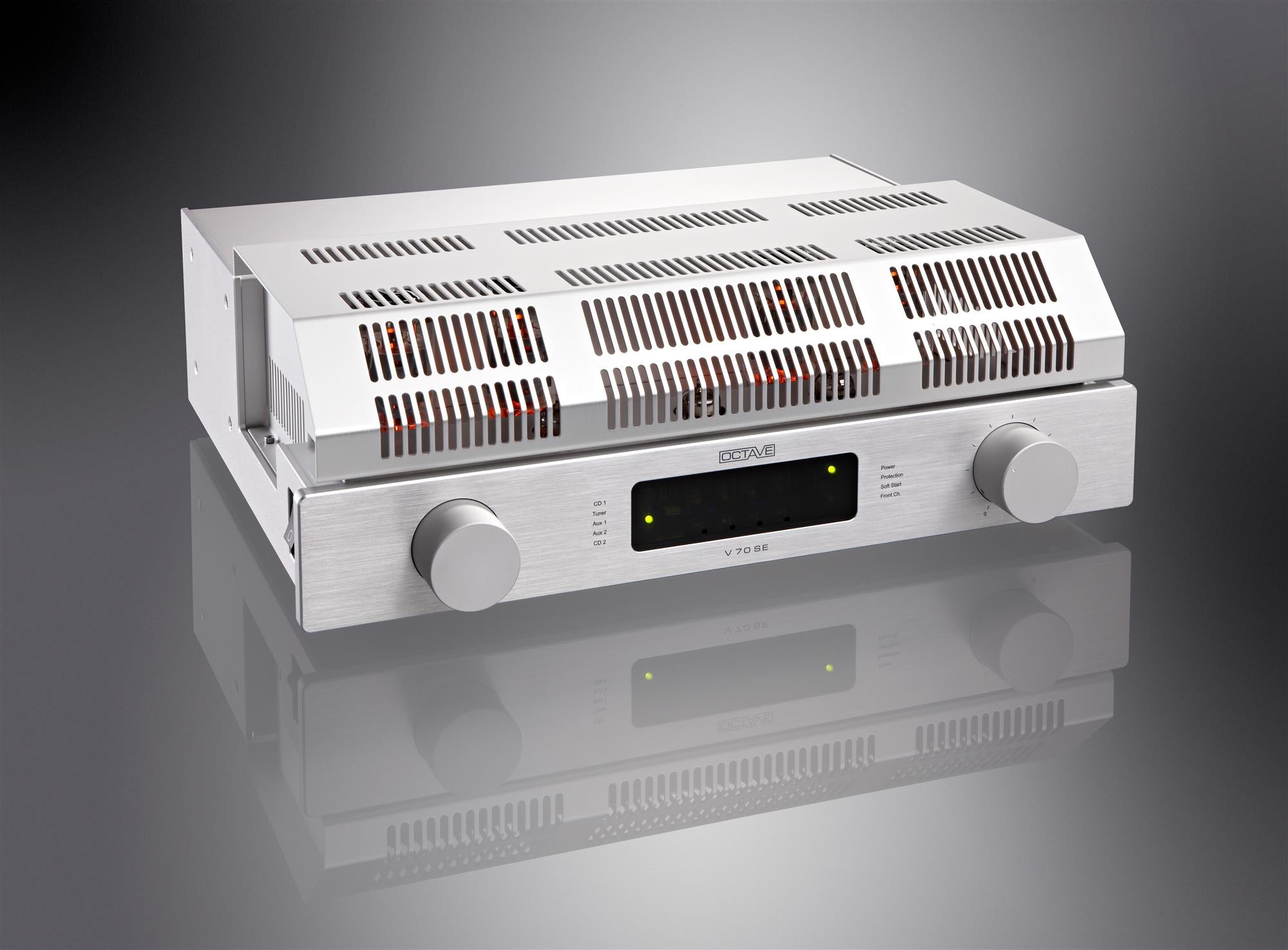
So similar – and so different
It’s easy to argue for valve amplifiers, which often have something about them that makes you want to sit a little longer and listen. There’s something about how organically and easily everything flows. Although the bass isn’t hard as concrete and the treble doesn’t extend far beyond what my ears can perceive, I find a good valve amp easy to like.
The Audio Research GSi75 and Line Magnetic 805 IA are two integrated valve amps with some distinct qualities that play wonderfully but sound different.
One – the GSi75 – has a weightlessness about it and a silky-smooth, high-resolution soundstage. The other sounds warmer and fuller, and has a more prominent bass response. But both can be said to have a signature sound that clearly stems from the fact that they use vacuum valves
I thought the Octave V 70 SE would have that too.
Modules
The German-built valve amplifier is one of many from Octave Audio, which specialises in valve amplifiers. It places itself in the middle of the field of the manufacturer’s integrated amplifiers. The V 70 SE is a more powerful version of the V 40 SE, and as the name suggests, the claimed power is 70 watts per channel. At 4 ohms, mind you.
The special thing about most Octave amplifiers is that they are built so that you can add, for example, a phono module or an extra input with either RCA or XLR connection. The modules cost a few hundreds extra, and for the integrated ones they can also be ordered, but then have to be fitted by a dealer. They are not plug-in modules.
For the V 70 SE specifically, you can choose a phono module with MM or MC input. The amplifier is already equipped with line inputs and outputs, and an XLR input for balanced cables.
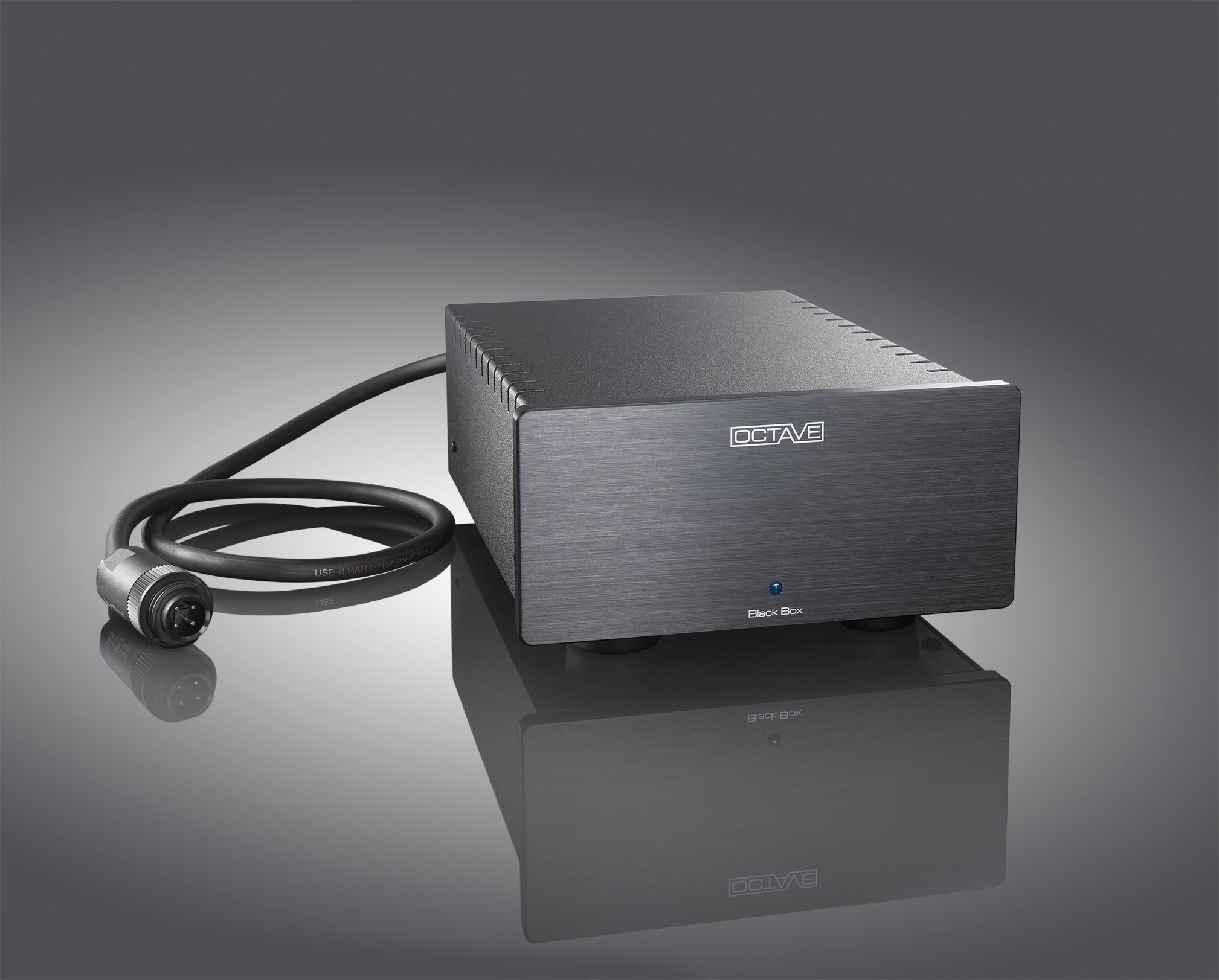
Black Box
It also has something quite unique to Octave: A separate input for a so-called Black Box, which is a separate box with extra capacitor capacity.
It comes in two sizes: the four-capacity Black Box (€1,170) and the ten-capacity Super Black Box (€3,100). Connecting a Black Box makes the amplifier more stable with speakers of low impedance, such as electrostatic speakers, which can have impedances as low as 2 ohms.
Octave boss Andreas Hofmann and his team believe the sound can be improved with a Black Box. Even if you don’t have speakers that are so demanding that the extra capacity is necessary. I’ll come back to that.
Bias
The V 70 SE has four 6550 valves in a push-pull configuration. It can also be equipped with four KT88 or EL34 tubes. Which, in simple terms, is the equivalent of different toppings on the pizza. The valves will change how the amplifier sounds, as will valves from different manufacturers. Sort of like the difference between a San Daniele and an Iberico ham.
Andreas Hofmann’s reliance on vacuum valves doesn’t mean the amplifier doesn’t have transistors or integrated circuits. They just aren’t part of the output signal and aren’t used for monitoring and automatically adjusting the bias current to the valves.
They are adjusted with a small screwdriver inserted into small holes in the front where the LEDs light up. Hofmann believes that manual bias is better than automatic because you can always check the state of the valves via the colour of the diodes and see when there is a deviation, or a valve is not energised, etc. Unlike many automatic solutions, which don’t warn you if something is wrong.
I’ve already mentioned the smaller 40-watt V 40 SE, but there’s also a V 70 Class A, which has four KT120 valves. It delivers a whopping 50 watts per channel in Class A operation with a Super Black Box connected. It uses dynamic bias control to compensate for the limited power that Class A usually has, but you can also adjust the bias manually if you want.
Eco-mode
The Octave V 70 SE is also equipped with an Eco mode, which can be selected with a rocker switch on the back. With Eco-mode activated, the amplifier turns off the power if there is no signal after ten minutes, to save the valves. Then the amp draws about 20 watts, but as soon as a signal is detected, the valves turn on and the amp is ready in seconds.
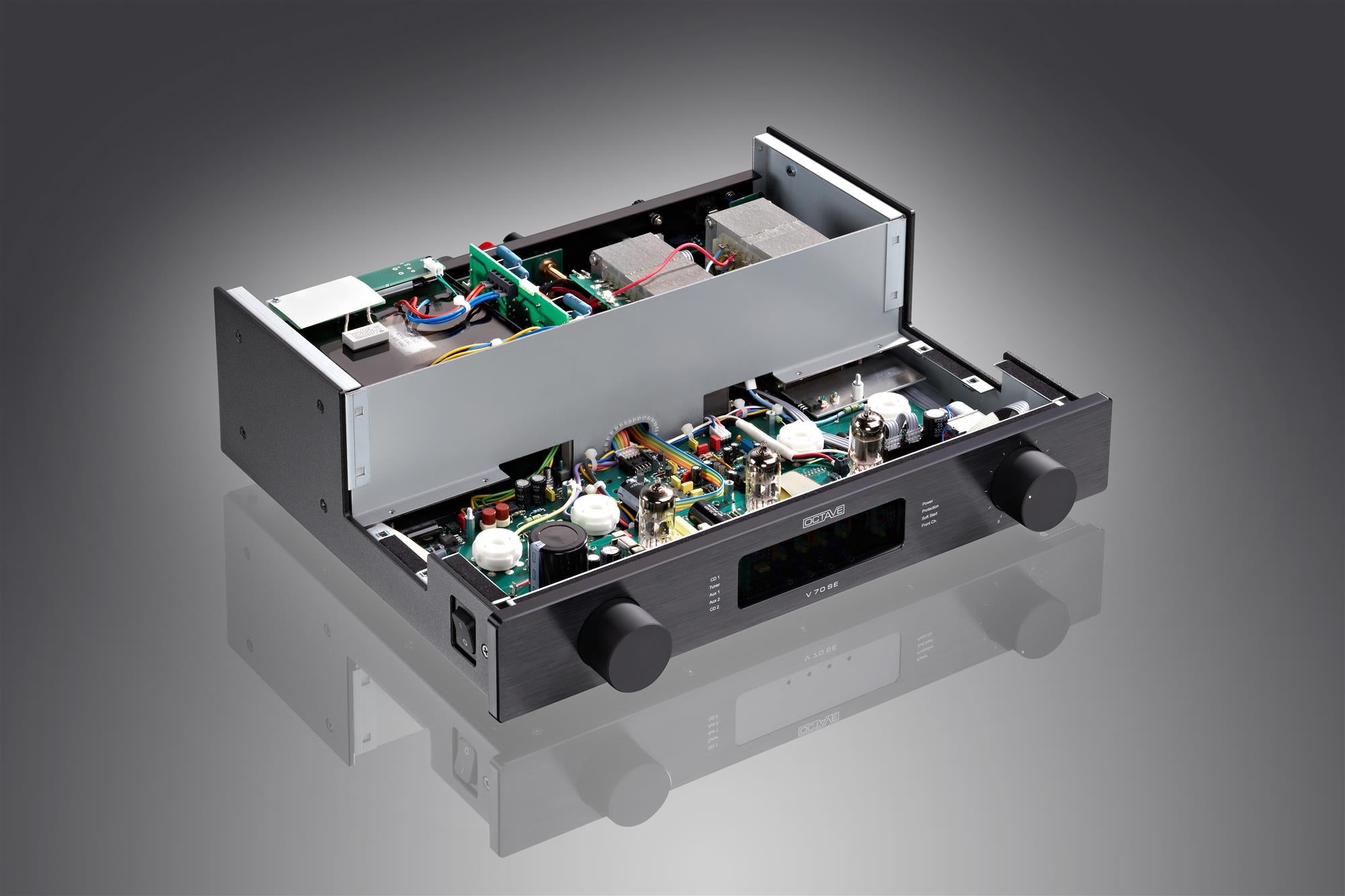
Doesn’t sound as expected
I wasn’t quite prepared for the sound of the Octave amplifier. Although I’d heard the Octave before, this was the first time I’d had one to test for several weeks. The black example I received came with a Black Box and an Octave F3 P filter. Which is an EMI filter that attenuates electromagnetic interference and is coupled between the signal source and the amplifier. Or between a preamp and a power amp.
I did not use the filter enough to include it in the test, but rather the V 70 SE with and without the Black Box.
Most of the testing was done with the outstanding KEF Reference 5 Meta speakers, which are relatively easy to drive. At first I thought they might be a size too big for the Octave amplifier, but I was wrong. It had fantastic bass control and managed to play much louder without audible distortion than I had dared hope.
The octave amp lacks some of the classic warm, rich sound that tube amps can often have, and in combination with certain speakers the sound can seem a little thin, almost cool. For example, single transistor amplifiers.
But as you listen to it and get to know it, you find that it plays rather more correctly than the common perception of tube amps would suggest.
“Cold Duck” by Al Jarreau can sound a little sharp in the treble, but there was not so much as a hint of that here, and the amp had shockingly good bass control on the big KEF speakers. It manages to go really deep into the bass with an authority not normally associated with tube amps, and it retains control in the lower octaves even when playing loud.
Personally, I’d like a little warmer piano sound and a little more fullness on vocals, but that’s a matter of taste, of course. Keith Jarrett’s Steinway grand piano didn’t sound thin at all, but the midrange didn’t have the same organic richness that I got with the Line Magnetic amplifier – or the Rotel Michi X5 (transistor), for that matter.
But the Octave V 70 SE makes up for it with a very well-focused soundstage that’s more transparent and detailed than the Line Magnetic amp’s and almost on par with the much more expensive GSi75 from Audio Research.
The small but high-powered Klipsch Heresy IV woke up to action with the Octave amp, sounding as dynamic and alive as I’ve hardly heard them before. But again, I thought the piano sound and vocals could do with a little more fullness.
The difference with and without the Black Box connected was less than I expected. This may be because none of the speakers I used were particularly heavy-duty, nor low-impedance or otherwise “troublesome”.
I would probably recommend inquiring at the store and of course borrowing one to take home if you think you might need the extra capacity. Since the Black Box also acts a bit like a filter, it does one thing with the sound that’s worth mentioning.
For me, the sound was a bit drier, the treble more calm and the bass tighter. The difference wasn’t huge, it has to be said, and I’m a little doubtful that the barely noticeable difference will be worth the money on all the speakers. But it doesn’t hurt to try.
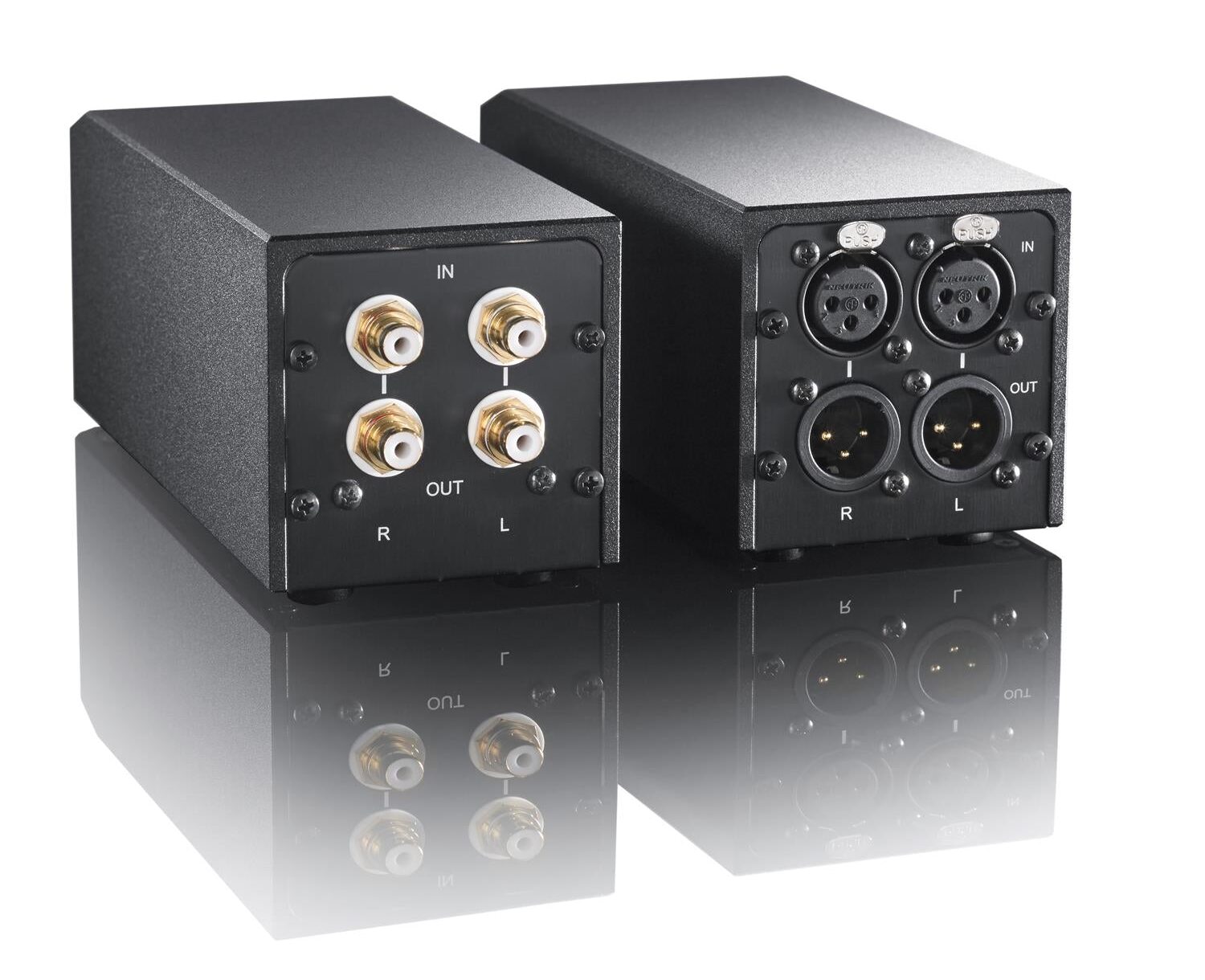
Conclusion
Octave Audio’s V 70 SE integrated amplifier will amaze others besides us. It truly shakes the prejudices that many have against valve amplifiers, and will win the enthusiasm of many for something they didn’t think they were ready for or interested in. It seems better built than many amps in higher price ranges, and sonically it can compete with many of them.
The V 70 SE has better control over dynamics when playing loud, and seemed completely unaffected when blasting music out through our large KEF speakers. With the option of turntable input and extra filter capacity for extra heavy-duty speakers, it’s also a little more flexible than most integrated amps.
The Octave is definitely worth a listen, if only to have your preconceptions about valve amps challenged.

We think
Steely bass control, expansive dynamics and astonishingly open and detailed sound. Plays louder and clearer than most valve amps. Phono input option and extended power capability if required. Expensive upgrades. It may need to be matched with the speakers' sound more acutely than other amplifiers.
6000 €
Specifications
- Type: integrated amplifier
- Technology: Vacuum valves
- Connections: 4 x analog, XLR
- Turntable input: No (optional)
- Headphone output: No
- DAC: No
- DAC Connections: None
- Power: 2 x 70 W into 4 ohms
- Frequency range: 20 Hz – 70 kHz (-1 dB, -3 dB)
- Dynamic range: (not specified)
- THD: 0.1% v. 10 W into 4 ohms
- Signal-to-noise: >100 dB
- Dimensions and weight: 45 x 15 x 49 cm / 23 kg
- Web: octave.de
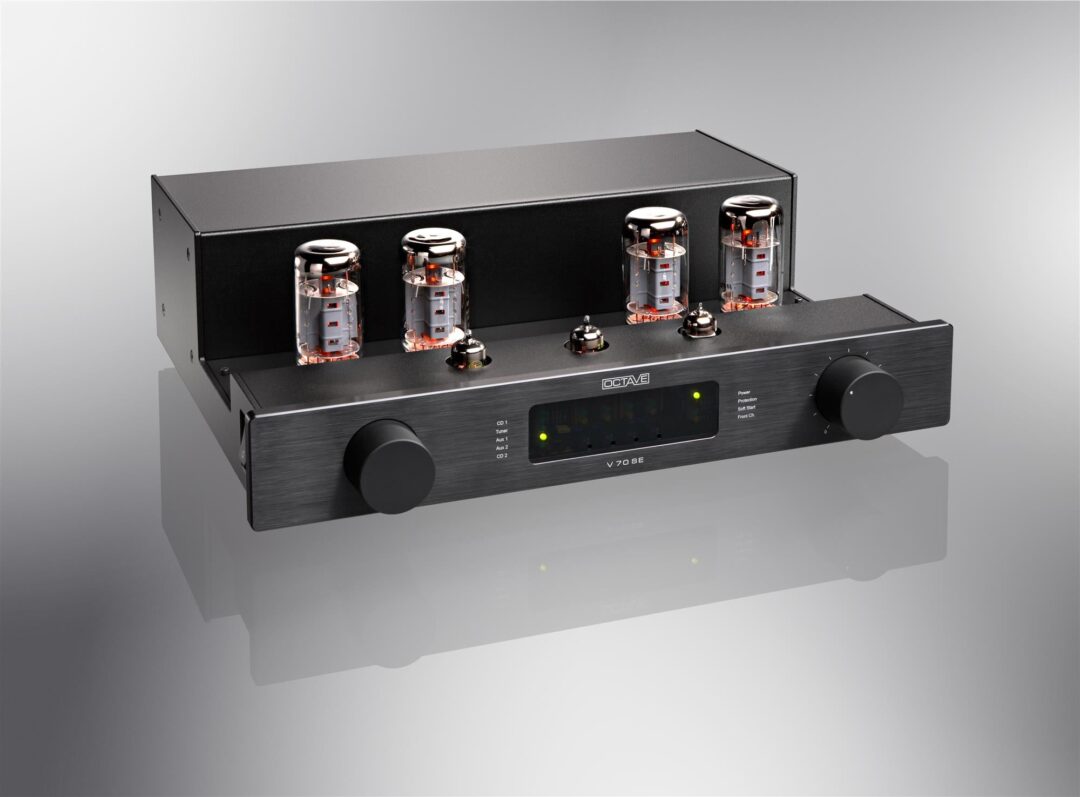

Nice review, I love the V70se, mulling over the black box but magnificent on its own driving Avalon speakers!
@Kenton
The super Black box is the finishing touch on this amp forget about the regular black box.
Once attached this will get the amp in the league off Audio Research Ref 75/110 amps
Stereo image might be a tad wider with the 110
And you will never ever wanne part with it or disconnect it from the octave.
Love my octave but whas shocked how good it gets with the super black box!!